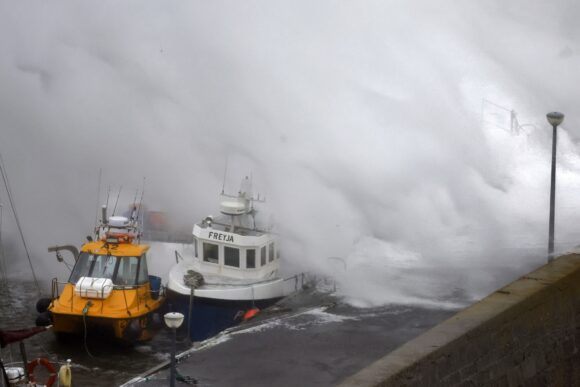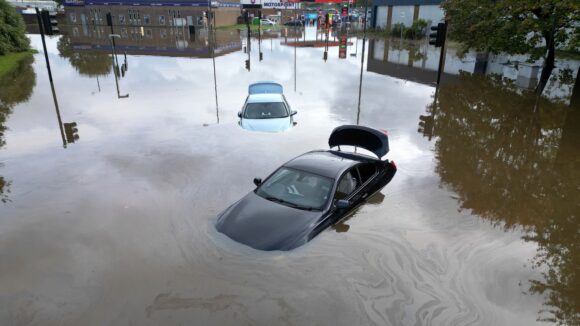The names Isha, Babet, and Henk will all be familiar to Britons, but not because they belong to people — they are some of the most destructive storms that have swept through the UK in the past year.
In an almost decade-long initiative, the UK Met Office has been naming storms that pose a significant risk to the British public. The program, which is conducted jointly with weather agencies in Ireland and the Netherlands, has made communicating the dangers of these weather events easier, inspiring people to prepare and protect themselves from high winds and flood waters, according to the Met Office’s Stephen Dixon. 2022’s Eunice and 2021’s Arwen also succeeded in capturing the national attention, appearing on newspaper front pages and at the top of news bulletins.
Dixon, who is a senior press officer, is part of the group that selects the roster of names every year. Names are chosen from public submissions or sometimes meteorological department colleagues make eponymous suggestions to honor those who are involved in severe weather responses. They are given out in alphabetical order as the storm season, which starts in September each year, runs its course. A storm is named when meteorologists think it’s likely to cause disruption or damage, through snow, wind or flooding.
Dixonspoke with Bloomberg Green about the UK’s unusually stormy winter this year and why communicating the dangers of severe weather is becoming more important, especially as global warming makes the impact of some events worse. A study from World Weather Attribution last month found the extreme rainfall that accompanied Storm Babet in October 2023 was made more likely and intense by climate change.
The conversation has been edited for length and clarity.
Bloomberg Green: The Met Office, in partnership with Ireland’s Met Éireann and the Netherlands’ KNMI, began naming storms in 2015. What’s the idea behind this initiative?
Stephen Dixon: It’s chiefly a communications tool. It helps in the ease of communication for not just our meteorologists, but also the media when they’re communicating severe weather. One of our missions at the Met Office is to help people make better decisions and to stay safe, and that very much comes into storm naming. It’s about helping the public understand what they can do to protect themselves in times of severe weather.
BG: How can you tell if you’re succeeding with this?
SD: We do post severe weather surveys of the public. We have research that storm naming works in terms of informing the public of those risks of severe weather. One recent example is for Storm Eunice, which was a couple of years ago: 98% of people within the red warning area in the south east of the country were aware of the warnings and the overwhelming majority of those took action to protect themselves.
BG: How do you know that naming the storm specifically helped?
SD: We know that amber warnings and red warnings [which indicate impact levels] get good awareness. But the name part of it adds a layer of awareness. When a storm is named, it very much elevates it in the media sphere. It provides a tangible point for the media to talk about the severe weather that’s in the forecast.
BG: This has almost been a record season for named storms in the UK. We haven’t yet tied 2015/16, which finished on Storm Katie. What can we take away from this extra active season?
SD: The storm naming season for us runs from the 1st of September through to the following end of August. We’re 10 names through the list and [so far] that was the quickest we’ve gone through 10.
It’s been a stormier than average winter, but one of the factors behind that is the position of the jet stream, a band of air high up in the atmosphere that dictates a lot of UK weather. The jet stream has been influencing our weather through the winter, as it’s been directed towards the UK, helping to deepen these low-pressure systems coming from western areas.
Year to year, and decade to decade, variability of storminess in the UK is quite large. In terms of reading anything more into that, it’s quite tricky to do.
BG: Is there any connection between winter storms and climate change?
SD: We do have records going back beyond storm naming in terms of wind speeds. It’s hard to detect a trend one way or the other in terms of the number and intensity of low-pressure systems that cross the UK in relation to climate change. However, what we do know is that our climate overall is getting wetter, particularly in the winter.
BG: Touching on that, has there been any talk of naming other weather events such as floods?
SD: I haven’t heard that being discussed in terms of floods, but when we name storms, it’s not just winds that are the only factor, although it’s a chief factor. We also consider when there’s impactful rain with low pressure systems. So one recent example of that would be Storm Babet, which brought some significant flooding to Scotland, and that was a factor in the naming of that storm.

BG: There’s already a move in Europe to start naming heat waves. Does the Met Office have any plans to do the same here in the UK?
SD: We have an extreme heat weather warning, which we introduced in recent years, which serves to inform the public about the risks that heat presents, particularly when we had 40 degrees Celsius in 2022.
There’s discussions at an international level [to name heat waves], but that’s as far as it is at the moment. It’s more complex [than] naming a low-pressure system, [where] it’s quite clear what you are naming.
BG: Finally, one last point on the heat waves last summer. I noticed the names that got attached to them were those of mythical beasts like Cerberus – which conjure up quite a scary image. Why have you gone for real people’s names with storms?
SD: We follow the convention set out by how hurricanes are named in North America. One of the factors [for us] is making sure that we’re using names that are recognizable and people would feel able to use. But then you can get into all sorts of arguments about what is a real name. You can name anyone anything really.
Photograph: Flooded cars are abandoned during Storm Babet in Derby, United Kingdom on on Oct. 21. 2023. Photo credit: Christopher Furlong/Getty Images
Topics Windstorm
Was this article valuable?
Here are more articles you may enjoy.



 Questions About How a Deputy’s Stepson Became the Accused Gunman at FSU Shooting
Questions About How a Deputy’s Stepson Became the Accused Gunman at FSU Shooting  Trump’s Trade War Is Making US Farmers Anxious About Demand Risk
Trump’s Trade War Is Making US Farmers Anxious About Demand Risk  Don’t Forget Tariff Impacts on Workers’ Compensation: Berkley
Don’t Forget Tariff Impacts on Workers’ Compensation: Berkley  Group Sues California Department of Insurance Over FAIR Plan Surcharges
Group Sues California Department of Insurance Over FAIR Plan Surcharges 

